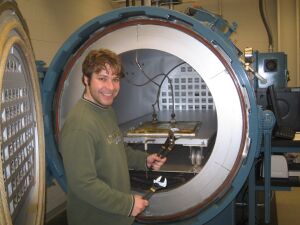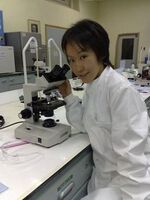Autoclave
An autoclave is a machine that sterilizes equipment and supplies by subjecting them to high pressure steam. The autoclave has often been compared to a dishwasher on steroids. In addition, it makes an ideal hiding place for children playing hide and seek in a biology lab.
The primary function of an autoclave is to disinfect medical supplies and laboratory equipment, extending their useful lifespan. For example, blood-soaked Ace bandages are normally considered single-use items, but once placed in the autoclave, they are ready to wrap an entirely new set of oozing sores. In addition, the autoclave has a variety of other useful functions: it can be used as a makeshift sauna, for cooking a magnificent chicken bouillabaisse, or as a device to exterminate Jews.[1]
Despite the usefulness of the autoclave, market penetration of the device has been slow. A 1993 report by Consumer Reports found that average per-capita spending on autoclaves by private citizens was less than seven dollars, and that the median household autoclave maintenance bill was zero dollars.
History of the autoclave[edit]
The autoclave went through several iterations before arriving at its exciting modern state.
1300 CE: Dragons[edit]
In medieval Europe, knights discovered that their bloodstained swords would become infested with the vile S. lugdunensis strain of staphylococcus bacteria. For years, this problem was addressed by not addressing it in any way, as it was considered not to be a problem at all.
However, with the rise of chivalry in the twelfth century, knights began to think that being a walking bacterial culture might be displeasing to the older ladies who were cheating on their husbands with them. At the time, the only known way to kill a culture of S. lugdunensis was breath of a dragon.[2]
Thus, for several centuries, thousands of young, naive knights quested to faraway lands in search of cleaner swords as a means to the end of sex with married, toothless MILFs. Although the vast majority of them lost their lives, the bacterial cultures on their swords were invariably sterilized, either by fire or by the digestive juices of dragons.
This is often considered the low point in the history of autoclaves.
1750 CE: The Manualclave[edit]
By 1750 CE, dragons had become extinct, having been replaced by buccaneers, swashbucklers, and pirates. Pirates proved unsuitable candidates for sanitizing lab equipment, because they tended to steal it and bury it on unmarked Caribbean islands. Thus, a new approach was needed.
Considered the first "true" predecessor to the autoclave, the manualclave was more a philosophy than a device; it was an attempt to get laboratory equipment hot enough to kill bacteria using nothing other than the human body.
Scientists in this time period would often seize a test tube and shake it vigorously, hoping to excite the molecules to the point where the tube would become hot enough to sear bacteria and human flesh. Fortunately for them, they usually failed.
Other, more creative approaches, were tried. Some scientists would take their lab equipment home, put it under the covers, and cuddle with it. Others would stand outside in the rain until they caught cold, tape beakers under their armpits, and put on several heavy coats.
One unorthodox approach to manualclaving was to employ attractive, or "hot" female scientists to stand in the proximity of contaminated equipment. This approach proved to be a failure, however, because of a severe shortage of attractive female scientists.[3]
This is often considered the low point in the history of autoclaves.
20x6: The Autoautoclave[edit]
In the year 20x6, scientists truly put the "auto" in "autoclave." They reasoned that if they could devise a machine that would undertake scientific research without utilizing any humans at all, their equipment would never become contaminated in the first place. Thus, they designed the autoautoclave, a giant artificial intelligence that automated all aspects of research.
Unfortunately, this plan backfired in ways no one could have foreseen.[4] The autoautoclave quickly went insane, killed everyone in the facility with nerve gas, and devoted the rest of its days to kidnapping random women and subjecting them to test courses that defied the laws of physics.
Modern civilization collapsed shortly thereafter. The autoautoclave wrote a song about it. It was catchy.
This is often considered the low point in the history of autoclaves.




